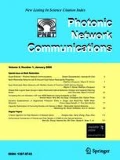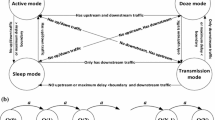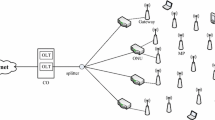Abstract
The Ethernet passive optical network provides broadband Internet access but also consumes a lot of energy. Energy saving mechanisms using the dual-mode—Active and Sleep modes—design for optical network unit (ONU) in EPON still suffer unnecessary energy consumption, especially in asymmetric data flow such as video streaming downloading service. The Doze mode is particularly suitable for handling the asymmetric data flow since it allows the ONU’s transmitter to turn off while turning on its receiver to receive data from optical line termination (OLT). However, adding Doze mode into original dual-mode design incur a greater challenge for OLT to identify the current status of the ONU since the ONU cannot transmit any upstream message to OLT at either Doze or Sleep mode. In this paper, we propose a new QoS provisioning tri-mode energy saving scheme, by integrating the Doze mode into original dual-mode design, to allow the ONU to switch to one of the energy saving modes whenever no upstream traffic exists. A high-priority upstream packet, arriving at ONU of energy saving modes, is able to trigger the ONU back to Active mode for QoS provisioning purpose. Performance evaluation via simulation has demonstrated the effectiveness of such mechanism in various asymmetric data flow. Furthermore, we propose two additional enhanced approaches to increase the energy saving effects by deferring the triggering action of the high-priority upstream packet as well as coalescing new arrival packets during waiting time into the same scheduling cycle.















Similar content being viewed by others
References
Kubo, R., Kani, J., Fujimoto, Y., Yoshimoto, N., Kumozaki, K.: Adaptive power saving mechanism for 10 Gigabit class PON systems. IEICE Trans. Commun. E93–B(2), 280–288 (2010)
Guo, X., Shou, G., Xiao, Q., Hu, Y., Guo, Z.: Toward green PON with adaptive sleep mode. In: IC-NIDC, pp. 184–188 (2012)
Yan, Y., Wong, S.-W., Valcarenghi, L., Yen, S.-H., Campelo, D. R., Yamashita, S., Kazovsky, L., Dittmann, L.: Energy management mechanism for Ethernet passive optical networks (EPONs). In: IEEE International Conference on Communications (ICC), 2010, pp. 1–5 (2010)
Mandin, J.: EPON powersaving via sleep mode. In: IEEE 802.3av Meeting (2008)
Shi, L., et al.: Efficient PON with sleep-mode ONU: progress, challenges, and solutions. IEEE Netw. Mag. 26(2), 36–41 (2012)
Kramer, G., Mukherjee, B., Pesavento, G.: IPACT: a dynamic protocol for an Ethernet PON (EPON). IEEE Commun. Mag. 40(2), 66–73 (2002)
Ma, M., Zhu, Y., Cheng, T.: A bandwidth guaranteed polling MAC protocol for Ethernet passive optical network. Proc. IEEE INFOCOM 1, 22–31 (2003)
Zhang, L., et al.: Dual DEB-GPS scheduler for delay-constraint applications in Ethernet passive optical networks. IECE Trans. Commun. E86–B(5), 1575–1584 (2003)
Choi, S.-I., Huh, J.-D.: Dynamic bandwidth allocation algorithm for multimedia services over Ethernet PONs. ETRI J. 24(6), 465–468 (2002)
Assi, C., et al.: Dynamic bandwidth allocation for quality-of-service over Ethernet PONs. IEEE JSAC 21(9), 1467–1477 (2003)
Hosseinabadi, Mina Taheri, Ansari, Nirwan: Multi-power-level energy saving management for passive optical networks. J. Opt. Commun. Netw. 6(11), 965–973 (2014)
Liu, C.-P., Wu, H.-T., Chiang, Y.-T., Chien, S.-C., Ke, K.-W.: An energy saving mechanism of EPON networks for real time video transmission. In: 7th International Conference on Digital Image Processing, Los Angeles (2015)
Kramer, G.: On generating self-similar traffic using pseudo-Pareto distribution. University of California, Davis (2001)
Dinh, N., Walid, A.: Power saving protocol for 10G-EPON systems: a proposal and performance evaluations. In: IEEE GLOBECOM, Anaheim, CA (2012)
Shi, L., Mukherjee, B., Lee, S.-S.: Energy-efficient PON with sleep-mode ONU: progress, challenges, and solutions. IEEE Netw. 26, 36–41 (2012)
Herreria-Alonso, S., Rodriguez-Perez, M., Fernandez-Veiga, M., Lopez-Garcia, C.: On the use of the doze mode to reduce power consumption in EPON systems. J. Lightwave Technol. 32, 285–292 (2013)
Suzuki, N., Kobiki, K., Igawa, E., Nakagawa, J.: Dynamic sleep-mode ONU with self-sustained fast-lock CDR IC for burst-mode power saving in 10 G-EPON systems. IEEE Photonics Technol. Lett. 23, 1796–1798 (2011)
Igawa, E., Nogami, M., Nakagawa, J.: Symmetric 10G-EPON ONU burst-mode transceiver employing dynamic power save control circuit. In: IEEE Optical Fiber Communication Conference and Exposition (OFC/NFOEC), Los Angeles, CA (2011)
Author information
Authors and Affiliations
Corresponding author
Rights and permissions
About this article
Cite this article
Liu, CP., Wu, HT. & Ke, KW. The QoS provisioning tri-mode energy saving mechanism for EPON networks. Photon Netw Commun 33, 26–38 (2017). https://doi.org/10.1007/s11107-016-0616-5
Received:
Accepted:
Published:
Issue Date:
DOI: https://doi.org/10.1007/s11107-016-0616-5




